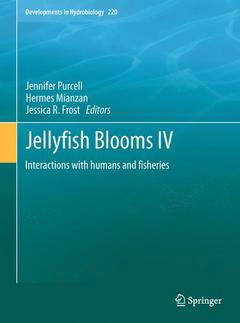Description
Jellyfish Blooms IV, 2012
Interactions with humans and fisheries
Developments in Hydrobiology Series, Vol. 220
Coordinators: Purcell Jennifer, Mianzan Hermes, Frost Jessica R.
Language: English
Jellyfish Blooms IV
Publication date: 11-2014
292 p. · 19.3x26 cm · Paperback
Publication date: 11-2014
292 p. · 19.3x26 cm · Paperback
Jellyfish Blooms IV
Publication date: 10-2012
292 p. · 19.3x26 cm · Hardback
Publication date: 10-2012
292 p. · 19.3x26 cm · Hardback
Description
/li>Contents
/li>Comment
/li>
Jellyfish generally are considered to be nuisances because they interfere with human activities by stinging swimmers, clogging power plant intakes and nets of fishermen, killing fish in aquaculture pens, and being both predators and competitors of fish. There is concern that environmental changes such as global warming, eutrophication, over-fishing, and coastal construction may benefit jellyfish populations. During this past decade following the first Jellyfish Blooms volume, some species have bloomed more frequently, expanded their range, and caused more problems for humans. Mnemiopsis leidyi, the ctenophore that invaded the Black Sea in the 1980s and damaged fisheries, now also blooms in the North, Baltic, and Mediterranean seas. Nemopilema nomurai, a giant Asian jellyfish, has bloomed frequently during this decade, causing severe damage to the Japanese fishing industry. Jellyfish Blooms: Interactions with Humans and Fisheries is the fourth volume in this series. Syntheses andoriginal research articles address the question if jellyfish have increased globally and what factors may have contributed to the abundance of jellyfish. This volume is the most extensive to date, containing papers from all continents (except Antarctica) on scyphozoans, hydrozoans, cubozoans, staurozoans, and ctenophores, and on the fate of jellyfish blooms. This is a key reference for students and professional marine biologists, oceanographers, and fishery scientists and managers. Previously published in Hydrobiologia, vol. 690, 2012?
PART I: JELLYFISH BLOOMS.- PART II: JELLYFISH BLOOMS AND THEIR CONSEQUENCES.- PART III: POTENTIAL CONTROLS ON JELLY POPULATIONS: ENVIRONMENTAL FACTORS, PREDATION, AND PARASITISM.- PART IV: FATE OF JELLYFISH BLOOMS.- PART V: CUBOMEDUSAN BIOLOGY.
Fourth and to date the most extensive volume on jellyfish blooms Aims at understanding the dynamics and impacts of jellyfish blooms at a global scale Addresses possible linkage between climate change and jellyfish blooms Looks into causes of jellyfish abundance Focuses on fish–jellyfish interactions, and fisheries
© 2024 LAVOISIER S.A.S.




